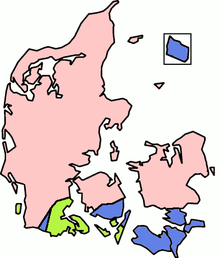Stød

The bump or bump ( Danish stød ) is a glottal stop or larynx closure . It is a typical pronunciation feature of the Danish language .
In IPA phonetic transcription of the impact sound with the symbol [ ʔ ] designated; An apostrophe ['] is often used in non-scientific Danish dictionaries . This is of the vertical emphasis mark (accent stroke) [ ] to distinguish.
In Danish, the impact sound is not viewed as a speech sound, but as an accent. The question of whether it is a separate phoneme is disputed . In terms of linguistic history, the impact tone corresponds to the musical two-syllable accent of Swedish and Norwegian . To this day, the musical accent can also be found in the Danish dialects in Southeast Jutland and on Ærø and Langeland . It is believed that Danish also had this accent system, which however developed into a touch tone in the Middle Ages (see also: Accents in the Scandinavian languages ). Various theories were proposed to explain the cause: Low German influence, the development of urban prestige, internal linguistic dynamics, etc. a. However, the thesis of the Low German influence contradicts the fact that a belt in southern Denmark in particular never adopted the tone.
The Danish shock tone is much softer than z. B. the corresponding Arabic glottal stop . For foreigners, it is important to ensure that the current language is not a complete, but only a partial larynx closure, a larynx tension that can vary greatly in strength, depending on the accentuation of the respective word in the sentence. An exaggerated larynx closure often reveals foreigners who otherwise have an error-free Danish pronunciation. The complete absence of the shock sound is, of course, an even more strange feature.
The sound also occurs in North German dialects, e.g. B. in words like remember / mɛrʔkən /, come / kɔmʔən /. In Standard German, the sound (also known as the glottic stroke) occurs only in front of vowels at the beginning of a syllable or word, for example in note / bəʔaxtən /, remember / ʔerʔɪnərn /. In the English Cockney it is widespread, e.g. B. in bottle [ ˈbɔʔɫ ].
In some dialects along the west coast of Jutland and on northwestern Funen, a complete glottal stop occurs in addition to the usual Danish sound. This is called V-stød or vestjysk stød (West Jutian shock) and, like the Cockney-English glottal stop, occurs especially before the plosives p, t, k . The West Jutian pronunciation [ ɛʔ ] of the Danish word itte, inte (≈ not) is very common; it corresponds to the pronunciation [ ɛʔt ], [ ət ], or [ it ] in other dialects. In imperial Danish the negation is called ikke .
In the case of Sydslesvigdansk of the Danish minority, the abrupt tone is omitted because this form of language is actually Danish on German soil. The original Danish dialects in the area also had no accent tone, but a tonal accent in the east (as in Angel Danish ), and neither a stroke tone nor a tone accent in the middle.
Web links
- Stød , dialekt.ku.dk
Individual evidence
- ↑ Dialekttræk . Københavns Universitet, dialekt.dk. Archived from the original on May 9, 2010. Retrieved September 27, 2016.
- ↑ Frederik Kortlandt: General Linguistics and Indo-European Reconstruction (PDF; 181 kB)